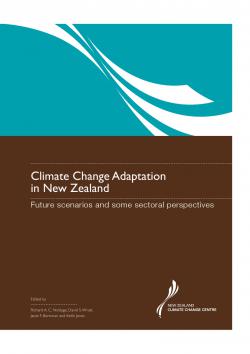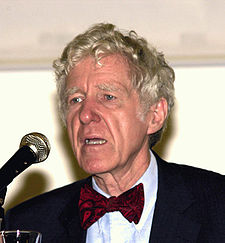Oil industry geologists have hardly been noted for their readiness to accept the findings of climate science. The American Association of Petroleum Geologists, a large international organisation of 31,000 members, is non-committal in its 2007 statement, though that was admittedly an advance on their previous rejection of anthropogenic warming. Bryan Lovell has worked as a BP geologist as well as an academic, but the title of his book is enough to indicate that non-committal is not for him: Challenged by Carbon: The Oil Industry and Climate Change.
In his acceptance of the case for anthropogenic global warming Lovell lays great stress on the evidence from the past, long before there were any of the human species to influence what happened. The Paleocene-Eocene Thermal Maximum (PETM), a warming event 55 million years ago, is his focus. It is preserved in the geological record and the changes it caused to life on the planet mark the boundary between the two epochs. First, a large quantity of carbon was released into the ocean-atmosphere over the geologically short period of some 10,000 years. Second, the temperature at the bottom of the ocean increased rapidly by more than 4 degrees over the same short period. Third, the oceans became notably more acidic. All this was accompanied by a general and significant global warming. It took some 200,000 years for the planet to return to something resembling the conditions prevailing before the massive and sudden release of carbon. Lovell remarks an ominously striking correspondence between the rate at which large volumes of carbon were introduced 55 million years ago and the rate at which large volumes are now being put into the atmosphere by us.
He considers the evidence of this event is more likely to carry weight with oil industry geologists than the computer-based models of complicated natural systems employed by climatologists. Geologists are “happiest when basing their predictions on the solid ground of rocks”. This may be a useful insight into the slowness of some geologists to take climate change seriously, but it left me wondering at the somewhat blinkered intellectual world which it suggests. I also wondered whether Lovell sufficiently appreciated the attention climatologists pay to the past in their predictions of what lies ahead. He acknowledges that the picture is somewhat mixed, but broadly sees climatologists focusing on predictions of the future, relying on a combination of past trends and computer modelling to make their forecasts, by contrast with geologists who look back in time. Is this contrast real? Leading climatologist James Hansen frequently stresses that his order of importance is first paleoclimate studies, then ongoing climate observations, with climate models in third place. Also detailed discussions of the PETM and other significant global change events in the past are common in books concerned with climate change. However, if only the story told by rocks will suffice for oil geologists so be it. It has certainly brought Lovell on board.
“It is now plausible for the geological community at large, not least those in the oil industry, to join with the climatologists and conclude that if we continue to release carbon dioxide into the atmosphere at the present rate we shall, this century, experience among other effects significant acidification of the world’s oceans and an overall global rise in sea level. Even at the lowest likely level these changes will have a significant adverse effect on our species and at their upper likely levels would be disastrous for many of us. How will the oil industry react?”
Lovell comments that protestations of virtue concerning climate change by oil companies have become a commonplace this century. Some may maintain a degree of cynicism as they read his descriptions of how this plays out within the industry itself, but he makes a reasonable case that there has been some change in industry perception. He acknowledges the contradiction in accepting the reality of anthropogenic climate change, yet predicting that fossil fuels will form an essential part of energy provision through to the middle of this century and beyond. He calls it not contradiction but paradox, as indeed it could prove if the serious industry investment in carbon capture and storage he urges were carried through to success.
It is this prospect which is the main burden of the book. Lovell sees little possibility of the world forsaking fossil fuels. “Lofty and high-level” arguments are unlikely to prevail in either the comfortable developed countries or the aspiring developing nations. They would need to be convinced that the rapid elimination of the oil and coal industries is really necessary. His book is not intended to offer such conviction.
What he does offer and advise is the engagement of the oil industry in carbon capture and storage. The scientific expertise it has gathered is highly relevant to the task:
“Petroleum engineers and petroleum geologists seek to understand the rocks beneath our feet, how fluids move through those rocks and how those elements may interact with the minerals lining the pore spaces and pore throats through which they travel. This understanding is just what is required to assess the suitability of any given location for the safe storage of carbon dioxide and to then store that gas securely within the rocks below.”
The details are followed through in some detail in a chapter headed Safe Storage: From Villain to Hero. Existing oil reservoirs offer useable opportunities, but not sufficient to satisfy the very large requirements. For that the use of saline aquifers will be needed. Lovell reports studies on the feasibility of such storage, some of them dealing with the reaction of the reservoir rock to fluids made more acid by the addition of injected carbon dioxide. Careful assessment of prospective sites is required. He is cautious in his appraisal, but optimistic that carbon dioxide can be safely trapped in reservoirs over geological timescales. Along the way he acknowledges the work of Kelemen and Matter (reported here in Hot Topic) on the possibility of trapping carbon dioxide in a type of igneous rock – peridotite – with which it would react rapidly. The concern for him is the absence of natural seals in such a process, and he considers pilot ventures are likely to remain focused on sealed reservoirs.
Oil companies work for profit. That is why the issue of a carbon price is critical if the expertise of those companies is going to be harnessed to capture and store carbon. The price, says Lovell, has to reflect a real understanding of the danger of not controlling the release of carbon dioxide. Increased government regulation is essential to set the scene.
The book is lively and engaging and well worth attention. Lovell straddles two worlds which often enough appear to have little intercourse. Carbon capture and storage gets a mixed press in discussions of climate change mitigation. But if it really is feasible, and if setting a price on carbon will make it doable by those with the necessary expertise and finance, it has the potential to be a significant contributor to emissions reduction. Even if we find ways to replace fossil fuel much more quickly than Lovell envisages we will still need to sequester some of the excess carbon with which the atmosphere is already overloaded.
[Purchase from Fishpond (NZ), Amazon.com (US), Book Depository (UK, free shipping worldwide)]

 Severe risks to human health will accompany the disturbed global climate which comes with global warming. We have only to consider the consequences of the heat waves, the flooding, the African droughts, of recent times to be alerted to that. Our experiences of climate change in New Zealand are unlikely to reach such extreme levels, but we would be wise to think and prepare ahead for the kind of human health hazards we may expect to encounter. Chapter 8 in Climate Change Adaptation in New Zealand (pdf
Severe risks to human health will accompany the disturbed global climate which comes with global warming. We have only to consider the consequences of the heat waves, the flooding, the African droughts, of recent times to be alerted to that. Our experiences of climate change in New Zealand are unlikely to reach such extreme levels, but we would be wise to think and prepare ahead for the kind of human health hazards we may expect to encounter. Chapter 8 in Climate Change Adaptation in New Zealand (pdf  One of the things that persuaded Gwynne Dyer that it was time to write his book
One of the things that persuaded Gwynne Dyer that it was time to write his book  “Sometimes dead really is dead — and for this Congress, barring a miracle, climate action is finished. With an ugly election looming in November, it may be years before we get another chance to debate a bill that prices carbon.”
“Sometimes dead really is dead — and for this Congress, barring a miracle, climate action is finished. With an ugly election looming in November, it may be years before we get another chance to debate a bill that prices carbon.”